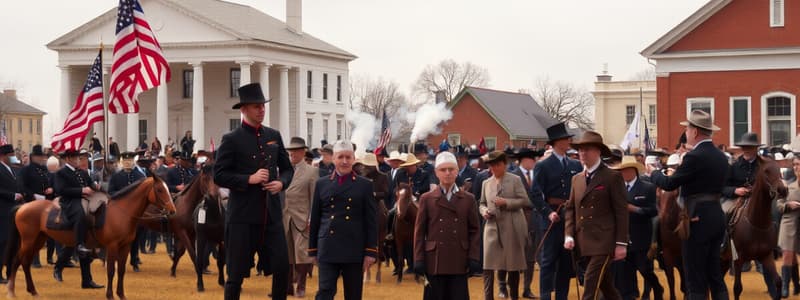Podcast
Questions and Answers
What was a significant consequence of the return to power of pre-war southern leadership during Reconstruction?
What was a significant consequence of the return to power of pre-war southern leadership during Reconstruction?
- Rapid approval of the Fourteenth Amendment.
- Republican control over Reconstruction efforts. (correct)
- Increased support for the Fifteenth Amendment.
- Strengthening of African American voting rights.
Which amendment is primarily associated with granting citizenship rights to all persons born or naturalized in the United States?
Which amendment is primarily associated with granting citizenship rights to all persons born or naturalized in the United States?
- Fourteenth Amendment (correct)
- Thirteenth Amendment
- Nineteenth Amendment
- Fifteenth Amendment
What primarily characterized the Reconstruction governments established in the South?
What primarily characterized the Reconstruction governments established in the South?
- Continuation of pre-war economic policies.
- Unrestricted voting rights for all citizens.
- Significant opposition from federal forces.
- Inclusion of African Americans in political office. (correct)
What organization emerged as a primary form of intimidation against African Americans during Reconstruction?
What organization emerged as a primary form of intimidation against African Americans during Reconstruction?
What was one of the challenges African Americans faced as Reconstruction came to an end?
What was one of the challenges African Americans faced as Reconstruction came to an end?
What was one of the key issues that Reconstruction aimed to address regarding African Americans?
What was one of the key issues that Reconstruction aimed to address regarding African Americans?
Which major event led Republicans in Congress to take control of Reconstruction?
Which major event led Republicans in Congress to take control of Reconstruction?
What was one purpose of the Fourteenth Amendment during Reconstruction?
What was one purpose of the Fourteenth Amendment during Reconstruction?
How did President Johnson's approach to Reconstruction differ from that of Congress?
How did President Johnson's approach to Reconstruction differ from that of Congress?
What challenge did Reconstruction governments face in the South?
What challenge did Reconstruction governments face in the South?
What method did organizations like the Ku Klux Klan use during Reconstruction?
What method did organizations like the Ku Klux Klan use during Reconstruction?
What was a significant outcome of the passage of the Fifteenth Amendment?
What was a significant outcome of the passage of the Fifteenth Amendment?
Which area experienced rebuilding efforts as Reconstruction came to an end?
Which area experienced rebuilding efforts as Reconstruction came to an end?
President Johnson's Reconstruction Plan prioritized the rights of African Americans.
President Johnson's Reconstruction Plan prioritized the rights of African Americans.
The Fourteenth Amendment was designed to grant citizenship to all people born in the United States.
The Fourteenth Amendment was designed to grant citizenship to all people born in the United States.
The Ku Klux Klan emerged during Reconstruction as a form of support for African Americans.
The Ku Klux Klan emerged during Reconstruction as a form of support for African Americans.
The Fifteenth Amendment aimed to protect the voting rights of African American men.
The Fifteenth Amendment aimed to protect the voting rights of African American men.
Reconstruction governments in the South were widely accepted and supported by the majority of white Southerners.
Reconstruction governments in the South were widely accepted and supported by the majority of white Southerners.
As Reconstruction ended, African Americans encountered fewer obstacles to their rights and opportunities.
As Reconstruction ended, African Americans encountered fewer obstacles to their rights and opportunities.
Congress took control of Reconstruction as a response to the ineffective leadership of President Johnson.
Congress took control of Reconstruction as a response to the ineffective leadership of President Johnson.
Rebuilding southern industry was a primary focus of Reconstruction.
Rebuilding southern industry was a primary focus of Reconstruction.
What role did Congress play in shaping the direction of Reconstruction after President Johnson's leadership?
What role did Congress play in shaping the direction of Reconstruction after President Johnson's leadership?
Which of the following accurately describes the impact of the Reconstruction Amendments on African American rights?
Which of the following accurately describes the impact of the Reconstruction Amendments on African American rights?
What was a major consequence of the emergence of the Ku Klux Klan during Reconstruction?
What was a major consequence of the emergence of the Ku Klux Klan during Reconstruction?
Which factor most directly influenced the ending of Reconstruction?
Which factor most directly influenced the ending of Reconstruction?
How did the goals of Reconstruction differ between President Johnson and Radical Republicans?
How did the goals of Reconstruction differ between President Johnson and Radical Republicans?
What was a significant challenge faced by Reconstruction governments in the South?
What was a significant challenge faced by Reconstruction governments in the South?
What was one of the primary aims of the Fifteenth Amendment during Reconstruction?
What was one of the primary aims of the Fifteenth Amendment during Reconstruction?
What was a direct effect of the passage of the Fourteenth Amendment?
What was a direct effect of the passage of the Fourteenth Amendment?
Flashcards are hidden until you start studying
Study Notes
Reconstruction Overview
- Reconstruction aimed to rebuild the Union post-Civil War, addressing political, social, and economic issues in the South.
- The process was marked by struggles over political power and civil rights for African Americans.
Rebuilding the South
- Reconstruction commenced with challenges such as infrastructure damage and economic instability.
- The transition from slavery to freedom for African Americans involved legal and social transformations.
Freedom for African Americans
- Emancipation led to significant changes in the status of African Americans, striving for equality and civil rights.
- Freedmen sought opportunities in education, employment, and land ownership, facing a hostile environment.
President Johnson's Reconstruction Plan
- Johnson's approach favored leniency and rapid reintegration of Southern states without stringent safeguards for African American rights.
- His policies drew criticism for allowing former Confederates to reclaim political power.
Fight Over Reconstruction
- The emergence of former Confederates in power prompted conflict with the Republican-led Congress, which sought stronger measures.
- Johnson faced significant opposition from Congress, leading to his impeachment but ultimately acquittal.
Fourteenth Amendment
- Ratified in 1868, it granted citizenship to all persons born or naturalized in the U.S. and guaranteed equal protection under the law.
- Aimed to protect the rights of African Americans and curb the influence of Southern Democrats.
Congress Takes Control of Reconstruction
- Congressional Reconstruction imposed stricter requirements for Southern states to rejoin the Union, including military oversight.
- Republicans enacted legislation ensuring civil rights and protections for African Americans amid Southern resistance.
Fifteenth Amendment
- Ratified in 1870, it prohibited denying voting rights based on race, color, or previous servitude.
- Symbolized a major advancement in civil rights, despite ongoing disenfranchisement tactics in the South.
Reconstruction in the South
- Reconstruction governments were established, often facing challenges from insurgent groups and economic hardships.
- The Ku Klux Klan emerged to intimidate and suppress African American political participation and social mobility.
Reconstruction Ends
- By the late 1870s, federal support for Reconstruction dwindled, leading to the withdrawal of troops and the end of military governance in the South.
- This marked the resurgence of white supremacist policies and institutions, undermining gains made during Reconstruction.
Rebuilding Southern Industry
- The South attempted to diversify its economy from agriculture to industry, though progress was limited by economic conditions and social resistance.
Reconstruction in the North
- Northern states witnessed their own struggles with integrating returning soldiers and addressing civil rights post-war.
- The broader implications of Reconstruction efforts influenced national politics and civil rights debates beyond the South.
Reconstruction Overview
- Reconstruction aimed to rebuild the Union post-Civil War, addressing political, social, and economic issues in the South.
- The process was marked by struggles over political power and civil rights for African Americans.
Rebuilding the South
- Reconstruction commenced with challenges such as infrastructure damage and economic instability.
- The transition from slavery to freedom for African Americans involved legal and social transformations.
Freedom for African Americans
- Emancipation led to significant changes in the status of African Americans, striving for equality and civil rights.
- Freedmen sought opportunities in education, employment, and land ownership, facing a hostile environment.
President Johnson's Reconstruction Plan
- Johnson's approach favored leniency and rapid reintegration of Southern states without stringent safeguards for African American rights.
- His policies drew criticism for allowing former Confederates to reclaim political power.
Fight Over Reconstruction
- The emergence of former Confederates in power prompted conflict with the Republican-led Congress, which sought stronger measures.
- Johnson faced significant opposition from Congress, leading to his impeachment but ultimately acquittal.
Fourteenth Amendment
- Ratified in 1868, it granted citizenship to all persons born or naturalized in the U.S. and guaranteed equal protection under the law.
- Aimed to protect the rights of African Americans and curb the influence of Southern Democrats.
Congress Takes Control of Reconstruction
- Congressional Reconstruction imposed stricter requirements for Southern states to rejoin the Union, including military oversight.
- Republicans enacted legislation ensuring civil rights and protections for African Americans amid Southern resistance.
Fifteenth Amendment
- Ratified in 1870, it prohibited denying voting rights based on race, color, or previous servitude.
- Symbolized a major advancement in civil rights, despite ongoing disenfranchisement tactics in the South.
Reconstruction in the South
- Reconstruction governments were established, often facing challenges from insurgent groups and economic hardships.
- The Ku Klux Klan emerged to intimidate and suppress African American political participation and social mobility.
Reconstruction Ends
- By the late 1870s, federal support for Reconstruction dwindled, leading to the withdrawal of troops and the end of military governance in the South.
- This marked the resurgence of white supremacist policies and institutions, undermining gains made during Reconstruction.
Rebuilding Southern Industry
- The South attempted to diversify its economy from agriculture to industry, though progress was limited by economic conditions and social resistance.
Reconstruction in the North
- Northern states witnessed their own struggles with integrating returning soldiers and addressing civil rights post-war.
- The broader implications of Reconstruction efforts influenced national politics and civil rights debates beyond the South.
Reconstruction Overview
- Reconstruction aimed to rebuild the Union post-Civil War, addressing political, social, and economic issues in the South.
- The process was marked by struggles over political power and civil rights for African Americans.
Rebuilding the South
- Reconstruction commenced with challenges such as infrastructure damage and economic instability.
- The transition from slavery to freedom for African Americans involved legal and social transformations.
Freedom for African Americans
- Emancipation led to significant changes in the status of African Americans, striving for equality and civil rights.
- Freedmen sought opportunities in education, employment, and land ownership, facing a hostile environment.
President Johnson's Reconstruction Plan
- Johnson's approach favored leniency and rapid reintegration of Southern states without stringent safeguards for African American rights.
- His policies drew criticism for allowing former Confederates to reclaim political power.
Fight Over Reconstruction
- The emergence of former Confederates in power prompted conflict with the Republican-led Congress, which sought stronger measures.
- Johnson faced significant opposition from Congress, leading to his impeachment but ultimately acquittal.
Fourteenth Amendment
- Ratified in 1868, it granted citizenship to all persons born or naturalized in the U.S. and guaranteed equal protection under the law.
- Aimed to protect the rights of African Americans and curb the influence of Southern Democrats.
Congress Takes Control of Reconstruction
- Congressional Reconstruction imposed stricter requirements for Southern states to rejoin the Union, including military oversight.
- Republicans enacted legislation ensuring civil rights and protections for African Americans amid Southern resistance.
Fifteenth Amendment
- Ratified in 1870, it prohibited denying voting rights based on race, color, or previous servitude.
- Symbolized a major advancement in civil rights, despite ongoing disenfranchisement tactics in the South.
Reconstruction in the South
- Reconstruction governments were established, often facing challenges from insurgent groups and economic hardships.
- The Ku Klux Klan emerged to intimidate and suppress African American political participation and social mobility.
Reconstruction Ends
- By the late 1870s, federal support for Reconstruction dwindled, leading to the withdrawal of troops and the end of military governance in the South.
- This marked the resurgence of white supremacist policies and institutions, undermining gains made during Reconstruction.
Rebuilding Southern Industry
- The South attempted to diversify its economy from agriculture to industry, though progress was limited by economic conditions and social resistance.
Reconstruction in the North
- Northern states witnessed their own struggles with integrating returning soldiers and addressing civil rights post-war.
- The broader implications of Reconstruction efforts influenced national politics and civil rights debates beyond the South.
Reconstruction Overview
- Reconstruction aimed to rebuild the Union post-Civil War, addressing political, social, and economic issues in the South.
- The process was marked by struggles over political power and civil rights for African Americans.
Rebuilding the South
- Reconstruction commenced with challenges such as infrastructure damage and economic instability.
- The transition from slavery to freedom for African Americans involved legal and social transformations.
Freedom for African Americans
- Emancipation led to significant changes in the status of African Americans, striving for equality and civil rights.
- Freedmen sought opportunities in education, employment, and land ownership, facing a hostile environment.
President Johnson's Reconstruction Plan
- Johnson's approach favored leniency and rapid reintegration of Southern states without stringent safeguards for African American rights.
- His policies drew criticism for allowing former Confederates to reclaim political power.
Fight Over Reconstruction
- The emergence of former Confederates in power prompted conflict with the Republican-led Congress, which sought stronger measures.
- Johnson faced significant opposition from Congress, leading to his impeachment but ultimately acquittal.
Fourteenth Amendment
- Ratified in 1868, it granted citizenship to all persons born or naturalized in the U.S. and guaranteed equal protection under the law.
- Aimed to protect the rights of African Americans and curb the influence of Southern Democrats.
Congress Takes Control of Reconstruction
- Congressional Reconstruction imposed stricter requirements for Southern states to rejoin the Union, including military oversight.
- Republicans enacted legislation ensuring civil rights and protections for African Americans amid Southern resistance.
Fifteenth Amendment
- Ratified in 1870, it prohibited denying voting rights based on race, color, or previous servitude.
- Symbolized a major advancement in civil rights, despite ongoing disenfranchisement tactics in the South.
Reconstruction in the South
- Reconstruction governments were established, often facing challenges from insurgent groups and economic hardships.
- The Ku Klux Klan emerged to intimidate and suppress African American political participation and social mobility.
Reconstruction Ends
- By the late 1870s, federal support for Reconstruction dwindled, leading to the withdrawal of troops and the end of military governance in the South.
- This marked the resurgence of white supremacist policies and institutions, undermining gains made during Reconstruction.
Rebuilding Southern Industry
- The South attempted to diversify its economy from agriculture to industry, though progress was limited by economic conditions and social resistance.
Reconstruction in the North
- Northern states witnessed their own struggles with integrating returning soldiers and addressing civil rights post-war.
- The broader implications of Reconstruction efforts influenced national politics and civil rights debates beyond the South.
Studying That Suits You
Use AI to generate personalized quizzes and flashcards to suit your learning preferences.




